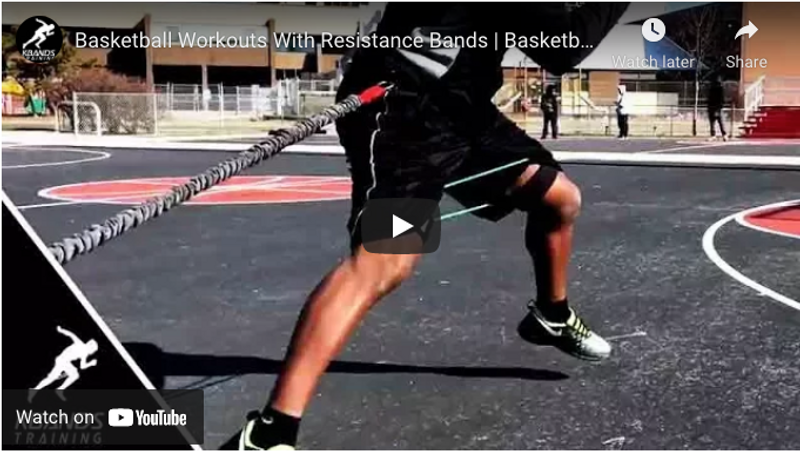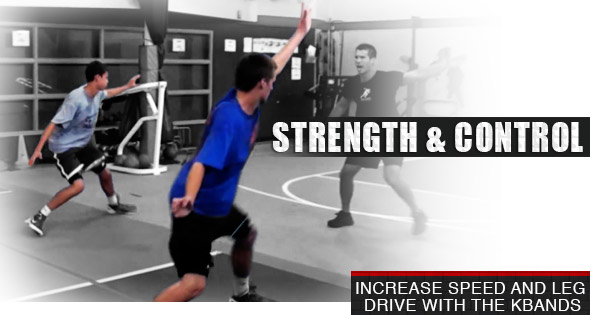Basketball Workouts with Bands
Resistance band training has its benefits in most sports, but where it has the most value is in rapid acceleration and deceleration training, and no sport typifies this sort of movement more than basketball. Basketball is about moving 0-60 at the drop of a hat. As an offensive player the quicker you make this transition, the more likely you are to beat the defense. As a defender, quick reactions and rapid acceleration is the difference between cutting off the lane and giving up a blocking foul. To increase these traits it is important to over-train. Over-training is the same principle used when lifting weights. Increasing the resistance/strain on the muscle will demand more from that muscle and in turn it will work harder and get stronger faster. Let’s look at an example of training with resistance bands and see how it works.
Lateral Bounding with Resistance
In this video we note the use of two separate types of bands, the Kbands around the knees, and the Reactive Stretch Cord attached at the waist. These bands are going to activate the muscles in ways that don’t normally occur during this drill. During lateral movements, the muscles of the legs exert only enough force to move the body the distance required (which is not much). However, by attaching bands the muscles must work against their resistance as well. This is the over-training mentioned above. Now the leg muscles are working harder than normally required for this drill, meaning muscle fatigue comes faster, meaning we’re working in our target zone longer. To build muscle we must work out to failure - when failure occurs the body uses the recovery days to strengthen the muscles that failed. In short, the body doesn’t like to fail and building muscle is the way it ensures it won’t fail next time. Let’s unpack this drill and see what’s happening.
Kbands Benefits For Basketball
The Kbands are placed above the knee and resist any motion where the knees are moved away from each other. In the Lateral Bounding Drill they are resisting the bound, and also the shuffle. This will activate the hip flexors and glutes during each movement and cause the accessory balance muscles to fire to compensate for the pull of the bands as the player takes off and lands. For proof of concept do empty hand bicep curls until it can’t be done any more (this will take awhile without the resistance of weight or a band). The same thing will happen without the Kbands while doing this drill. The player’s cardio will fail long before their legs do, and so the legs will not get stronger until the player’s conditioning is good enough to cause the muscles to be the weak point in the drill. By adding Kbands the focus is moved from the cardio limitations to the muscles we’re trying to strengthen.
Reactive Stretch Cord Benefits For Basketball
The Reactive Stretch Cord resists movement away from the anchor. During the Lateral Bounding Drill the Reactive Stretch Cord will constantly try to pull the player back to the sideline. This means that for the first part of the drill the player will be bounding away from the sideline with resistance trying to pull them back. This trains the muscles to incorporate a higher percentage of muscle fibers with every bound. In the second half of the drill the player bounds back towards the sideline with the Reactive Stretch Cord trying to accelerate the player. This requires resistance from the player with every landing. While the first part of the drill trains acceleration and explosiveness, the second part trains deceleration and control. This control will reduce injury and strengthen the balance muscles that keep the joints healthy.
Lateral Movement Training
Most actions the legs take occur in the sagittal plane. This is the plane that splits the body left and right. Walking, running, squatting, sitting, and jumping all occur along the sagittal plane primarily. However, In basketball many of the movements are occurring in the frontal plane. This is the plane that splits the body front and back. Cutting, defensive shuffles, cross-overs, and the first step in most drives are all examples of primarily frontal plane movements. Because these are not normal movements the body needs specific training to improve them. The Lateral Bounding Drill is a good example of a drill the focuses on the problem movement and adding resistance improves the drill by focusing on the muscles rather than a player’s cardio.
More Training with Bands
As mentioned above, the heart of resistance band training for the lower body is acceleration and deceleration training. On kbandstraining.com we have tons of drills and exercises for speed, acceleration, rapid cutting, and core stability. We also have an entire section devoted to Basketball focused movements and drills. To pick up the resistance bands discussed above or to find more training head over to kbandstraining.com.


